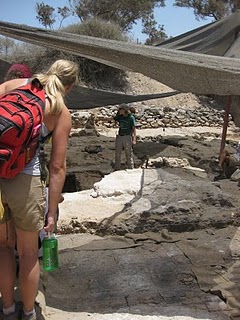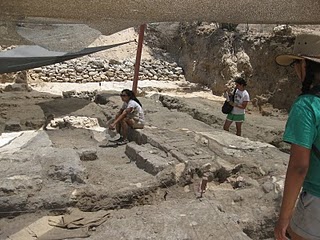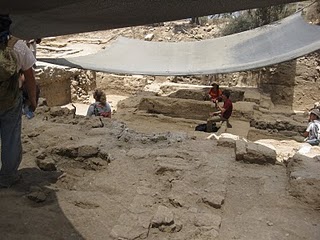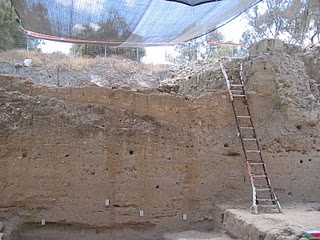The New York Times travel section is featuring an article on the expedition. You can read it here.
What to Bring
It's that time of year. I keep my eye out for sales on whatever it is I usually throw in my suitcase to bring to Ashkelon. So what can't you live without as you spend six fabulous weeks on the sunny Mediterranean coast of Israel? Turns out, not much. You can get by with very little. There are, of course, some things that you really do need and here is what I recommend. For some of you, this will be obvious and self explanatory. For others, everything about an archaeological expedition might new, strange and even unusual. So here goes.
Today, I'm talking about what you'll need in the field:
1. a bag or backpack (something to hold all your stuff)
2. water bottle (hydration is THE overriding health concern while doing physical labor in the hot sun)
3. hat (passing out from heat stroke is not a good thing)
4. sunscreen (the dirt will cover you pretty thoroughly but its a good idea to use sunscreen too)
5. trowel (Marshalltown trowels are the most common. Get a pointing one)
6. powdered drink mix (optional but helpful to have if 32+ ounces a day of water gets old)
7. notebook and pen (some of you will have to keep journals, others may just want to play hangman)
8. sunglasses (you don't usually wear them in the field but they're good for nap time during breaks)
9. granola bars (totally optional but some people like an extra snack)
10. proper attire (closed toed shoes, pants or shorts, t-shirts
11. camera (you will want to take pictures with some frequency)
There is, of course, an infinite variety associated with the above list. And I haven't even dealt with some of the other electronics that you'll want to bring. I think we'll save that for next time!
Finally today, a new "What? Where? When?" Can you guess what it is?

Leaving on a Jet Plane
It's a little over three months until the first wave of staff members head over to Ashkelon. Rumor has it that the Lab has undergone some significant changes, that it may not be recognizable to those of us who have gotten used to its dilapidated glory. The word "grass" has even been mentioned...
Wanna see it? Well, you have to get over there first and which airline you choose can either be a no-brainer or an lengthy process involving archaic formulas, a throw of the dice and who knows what else.
Since I first went to Ashkelon I've flown many different airlines: Tower, El Al, Air Canada, Swiss Air, KLM, Lufthansa, Iberia and maybe one or two I no longer remember.
My favorite stories come from the early years and were both on El Al. In the old days, way back when, the excavation organized group flights -- it also organized and sponsored trips to Egypt but that is another story and a lifetime away -- usually leaving from New York, usually on El Al. So my second or third year I was traveling on the group flight to Israel sitting behind Anna C., a very funny, smart supervisor. When it was time for dinner service the stewardesses came down the aisle asking passengers what they wanted to eat, "Chicken or beef?" Anna made the mistake of asking, "How is the chicken prepared?" The stewardess looked at her as only an Israeli can and replied, "It's hot and it's dead. What more do you want?"
The second story comes from a trip home when it turned out we were traveling with an American youth orchestra that had been in Israel performing. Halfway, perhaps earlier, into the flight they decided to play and to a one, the got out their instruments and started playing -- including a kid who got down on one knee by my seat and played his violin. It was certainly the most unique live musical performance I've ever heard.
What stories will you have to tell?
Scholarship Information Available
Scholarship information is available for the 2011 season.
Be sure to check it out here.
Pompeii and Preservation
For those interested, CNN has an interesting article on Pompeii and the preservation of the ancient site. Read about it here.
The new year is almost here and with it the countdown to the 2011 season. More about that coming soon!
Stormy Weather Reveals Ancient Roman Period Statue
For those of you who missed it today, CNN featured a story about a severe storm that hit Ashkelon and many other areas in Israel. In Ashkelon, the storm was so strong that it caused a section of the cliff along the coast to collapse. That collapse revealed a large piece of Roman period statuary that was discovered by a resident walking along the beach. The statue is of a woman wearing a toga and a pair of sandals. It is missing the head and arms but the statue is otherwise well preserved.
Click here to read the article.
The Humble Gaza Jar
The answer to the long ago "What? Where? When?" posted in September is the Gaza Jar. For a long time it was believed that the Gaza jar, generally used as a container to ship wine, ceased to be used after the Byzantine period. That assumption was tested when Gaza jars started appearing in Islamic period contexts, during the seventh and eighth centuries, at a number of sites in Israel. Gaza jar fragments are so common at Ashkelon in such contexts that there can be little doubt that they continued to be manufactured and used well after the Islamic conquest. Work we are currently doing at Ashkelon promises to shed more light on this important vessel and its use in the Byzantine and Islamic periods.
It is all in the timing
Oh, the thrill of a great idea and the agony of someone else beating you to it! Such is the story of our adventures with an iPad and lofty goals of pushing even further into the technology frontier during the 2010 field season.
Let me explain. Already advanced in the area of technology in the field, we do all our field recording on laptops and have for a number of years, I thought it would be great to explore using an iPad as well or even in place of the laptop. To that end I recruited a computer programmer (disclaimer: he is my husband) to come over for a month and see what he could come up with. The end result? Some good ideas and a lot more work. Turns out we weren't the only ones with the good idea. Excavators at the site of Pompeii had the same thoughts and a rousing cheer to them for employing some awesome technology in the field. Take a look.
Ahhh, to be featured on the Apple website. We even have action shots! And by the way, thanks to everyone who helped in our campaign to highlight the iPad in the field. We are still working on it so keep an eye out for what comes next!


Thoughts of Next Summer
Hi everyone! After a rather lengthy hiatus I'm back. The end of the season came and went in a flash. Staff week was, as always, a heady mixture of stress, relief, giddiness, shenanigans and, dare I say it, productivity. The fun and excitement included final photos, all of the grids looked spectacular for which our hard working volunteers deserve heaps of praise, the prize find in Grid 38 was removed safely and the Pottery Compound never looked better. Of course, there is always more work to be done and those of us crazy enough (put me at the top of the list) have already turned our thoughts to next season and what awaits.
Just a brief comment today starting with a big thank you to the volunteers and staff alike who joined us in the 2010 summer season which was a great success. I would like to thank the hardy souls who toiled away in Grid 47 meeting every challenge with enthusiasm and, perhaps, no small amount of insanity (kidding! mostly). Ryan, Robyn, Elise and Mark were fabulous supervising their squares and a real pleasure to work with (I expect to see all of you next year!). And our volunteers who went above and beyond what I could have hoped for: Alter (who came back for his third season in 47), John Charles, Travis, Krista, Mr. Goble (thanks for putting up with us), Ryan Goble (who made it through another season working for me), Amy (season number two and still going strong), Aaron, John, Emily, Wynn (season number two and didn't lose any of his enthusiasm), Heather, Christopher and last but definitely not least my nephew Bennet who managed to put up with his aunt the whole summer. They worked tirelessly the whole season which culminated in four excruciating days of cleaning with no shade cloths after the first day. And after those four days of cleaning the grid looked fabulous. I really hated to tromp all over the place when the photos were done but I did!

The other grids also looked great too (you should have seen the supervisors racing with brushes in hand trying to keep one step ahead of the photographer) and be sure to keep an eye out for the field report which will be posted when all the bits and pieces are gathered. Some final photos may make an appearance there.
So, next up ASOR to which I know a great number of Ashkelon people will be making their way. Atlanta anyone?
Now, I believe I have a long languishing "What? Where? When?" to answer or in this case a "Who?"
 Unless I am mistaken the answer is Lady Hester Stanhope who is most well known, perhaps erroneously, for smashing a larger than life statue to get at the treasure inside during her excavation of Ashkelon in the early 1800s. We aren't really sure where she excavated and, between you and me, aren't really sure of exactly what she found but she did dig in Ashkelon and plenty of people have plenty of things to say about her.
Unless I am mistaken the answer is Lady Hester Stanhope who is most well known, perhaps erroneously, for smashing a larger than life statue to get at the treasure inside during her excavation of Ashkelon in the early 1800s. We aren't really sure where she excavated and, between you and me, aren't really sure of exactly what she found but she did dig in Ashkelon and plenty of people have plenty of things to say about her.

Time for a new one. Quite famous in its own right, the object in this "What? Where? When?" is proving to be even more interesting than previously realized.
So Long Until Next Year
The volunteers have left, the grids are swept and ready for their moment in the sun (or out of it actually so that we can get good photographs tomorrow) and the bookwork continues.
The party was a rousing success and I suspect if you check Facebook many of our volunteers will already have posted pictures.

During the party Professor Stager honored two great friends of the excavation who we recently lost. First, Lord Anthony Quinton,
Lord Quinton readily shared his wit, wisdom and curiosity for the world around him during his annual summer visits with his wife, Lady Marcelle Quinton. Members of the expedition looked forward every summer to Lord Quinton's annual lecture which was delivered with admirable skill and a dry sense of humor.
Perhaps the greatest reward, however, was to talk about literature with him. Lord Quinton, who once possessed the largest private book collection in England, was as happy discussing his favorite childhood book, Treasure Island, as he was the latest philosophical text on the desk in his study. It is with great sadness that we mourn his loss.
This spring the expedition's long time major domo Moshe "Musa" Shimoni passed away and we lost a true friend and staunch ally. Musa was the go to guy and whatever we needed he made happen. Usually with wit and wisdom and a forbidding frown for anyone who got in his way. Musa and his wife Carmella provided the expedition with a valued friendship over the years and he will be missed.
Next time you see Professor Stager ask him about the time he and Musa had a close encounter with some young Orthodox Jews. It's a story that tells you just about everything you need to know.
Stay tuned for more pictures (the grids really do look great and you won't believe the transformation of grid 47 if I do say so myself) as well as the answer to the last, probably long forgotten "What? Where? When?"
So long until next year, the dirt is no longer available for excavation. Let the countdown to The Leon Levy Expedition to Ashkelon 2011 season begin.
Time for a Party
Just a quick hello as we get ready for the season ending dig party. Dr. Master's lecture is written and the Finds Display is being set up...

Tel Games

Let the Games begin Dr. Adam Aja proclaimed during Ashkelon's 3rd Annual Tel Games Extravaganza during the 5th week of excavation. You can see him below explaining the rules, the very long, complicated and involved rules of what promised to be the most epic version of the Games ever played! In an effort to limit the rampant cheating, both seen and unseen, in previous years Adam made this years games an individual competition.
Participants had to wear to flags and carry around a gufa. Within a designated area (which shrunk with each passing moment of competition) participants had to retrieve pot sherds from buckets placed in random spots throughout the field of play. Those worthy souls brave enough to participate had to retrieve as many sherds as possible (bodies = 1 pt. and diagnostics = 5 pts) and register them with the Registrar while keeping their flags.

Here you can see some of the participants lined up and ready to go.

Which one of these brave volunteers will win? And will they have to cheat to do it?

Angels of Death patrolled and ruthlessly policed the field of play and the status of each participant's flags. Lose one flag and the AD would pronounce the participant wounded which meant that they could only move with the help of a friend (ha ha, that never happened) or with one hand on the ground (while the other one still gripped the gufa full of potsherds). Drop the gufa or get the second flag stolen and the AD would pronounce the participant dead and out of the competition!

And to further complicate things there was an Antiquities Dealer strolling around... Lose a flag? You could trade potsherds for a new one with the Antiquities Dealer. If you trusted him...
In the end, the participant with the most points would win the coveted Ashkelon Cup.

Have you ever seen such a glamorous, prestigious trophy? Nor had any of us and as you might imagine everybody was eager to get their hands on it. (Larry worked very hard to make it. When you see him please tell him how lovely it is.)
It was cutthroat with contestants from Grids 38, 51 and 47 going after their own grid mates before moving on to the competition. The injured were plentiful and the participants quickly started dropping like the crows swooping down to snatch thet remains of Second Breakfast.

In the end Maria from Grid 51 was victorious! Yea Maria. Her name was the first to be inscribed on the coveted Ashkelon Cup. Who will it be next year?
Dig T-Shirt
It's here, the new 2010 Ashkelon dig shirt! 
Seen in the image is a decorated brazier fragment from the 2nd century BCE found during excavation in Grid 51. In the 2nd century cooking was often done by putting a metal stand over a fire. The decorated fragment of the brazier seen on the t-shirt would have been an insulater between the metal stand and the pot in which food would be cooking. We have good parallels for this from the site of Tel Dor.
A Race to Pottery Washing
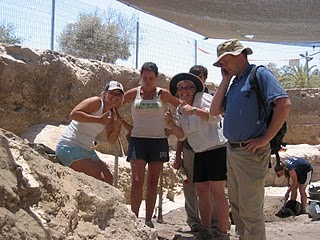
Quick, can I write an entry before pottery washing and still have time to get some Ice Coffee? Let's see.
Today, in our latest edition of "Getting to Know You" I'd like to introduce you to Dr. Daniel Master, Co-Director Ashkelon Excavations and Associate Professor of Achaeology at Wheaton College. Here goes.
Dr. Master doesn't remember what he wanted to be when he was little but he does remember that he was notorious for telling his cousins where to dig. Today, Dr. Master is still telling everyone where to dig. In fact, that is an important part of his job as co-director. Dr. Master's job is to plan the season's work, find people who want to do the same work and then make it happen and do whatever he can to make sure all the work gets done. His favorite part of the job is working with people he likes. And he has no least favorite part of the job because, he told me, if there was something he didn't like he would change it.
Favorite tool: Trowel
Most interesting find he has excavated: 604 BC destruction of Ascalon
Favorite treat while in Israel: Ben and Jerry's Cherry Garcia Ice Cream Bar covered in Dark Chocolate
BTW, the answer to the question is "no." I wasn't able to post this before pottery washing. At 8:19 it is now just 11 minutes until my bedtime. Until next time, the dirt is ready!
Getting to Know You

Today's installment of "Getting to Know You" features Robyn, a Ph.D. student in the Classics Department at the University of North Carolina. When I asked Robyn what she wanted to be when she was little she looked a little sheepish and confessed that she always wanted to be an archaeologist. There were obvious signs she told me. First, she was always digging in her back yard when she was a child. And, whenever she played with Barbie dolls she dressed them up as characters in Greek mythology!
Here on the Leon Levy Expedition to Ashkelon Robyn is a Square Supervisor in Grid 47. That means she oversees the day to day excavation of a 10 x 10 meter area within the grid. Robyn's favorite part of the job is the people. She loves meeting new people and teaching them about archaeology. Her least favorite part of the job are the spiders and lack of coffee.
Favorite Tool: WHS trowel
Least Favorite Discovery: A never ending pottery pit she excavated last year
Favorite treat while in Israel: Ice Aroma (basically a mix between a coffee slushie and a coffee milkshake)
Tel Tour
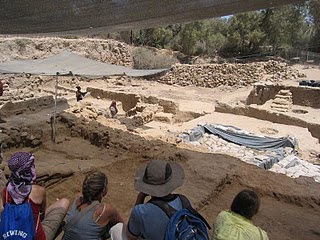
Today we had our first Tel Tour. It started in Grid 38 where Josh detailed the latest events. In Square 85 Johnathon and his volunteers have waded through Byzantine and Roman period drains on their way to the Persian period and, happily, what appears to be the first well preserved 8th century BCE floor ever found at Ashkelon. That is certainly a big discovery!
One of the goals of Square 85 is to keep moving towards the level of the gray sandbags you can see in this picture and the one below. Last year they uncovered a very important building dating to the Iron 1 period which extends into Square 85. Stay tuned for Johnathon's progress throughout the season as he gets closer and closer to uncovering the remainder of this important building.
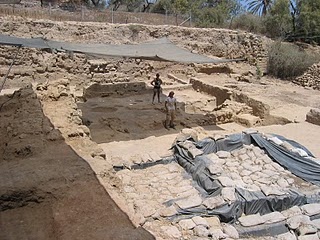 Further down in the grid in Dana's square they are dealing with fill layers from the LB 1 period and a house with a courtyard from the LB 2. (LB = Late Bronze Age. The approximate dates for LB 1 are 1550 - 1400 roughly and for LB 2 1400 -1200.)
Further down in the grid in Dana's square they are dealing with fill layers from the LB 1 period and a house with a courtyard from the LB 2. (LB = Late Bronze Age. The approximate dates for LB 1 are 1550 - 1400 roughly and for LB 2 1400 -1200.)
As mentioned previously, Grid 38 is the longest continually excavated grid on site but much of it is coming to the end of its long winding journey. Dana's may very well complete the excavation of his area this summer after which point Johnathon's square and the quest for the remainder of the Iron 1 building under the sandbags will be the focus of work.
 From Grid 38 it was on to Grid 51 and happily I have pictures! Up first, Kate, who you met in our first "Getting to Know You" segment. Here she is explaining her very interesting grid which is newly expanded this season. With the new expansion Kate and her team of supervisors find themselves dealing with a wide range of time periods. They have everything from Islamic and Crusader through the Persian period. All in all some very interesting stratigraphy.
From Grid 38 it was on to Grid 51 and happily I have pictures! Up first, Kate, who you met in our first "Getting to Know You" segment. Here she is explaining her very interesting grid which is newly expanded this season. With the new expansion Kate and her team of supervisors find themselves dealing with a wide range of time periods. They have everything from Islamic and Crusader through the Persian period. All in all some very interesting stratigraphy.
I have a few more details and, I hope, perhaps even a description of the grid from Kate herself who tells me she also has some great pictures to share.
They are very hard to see but if you look at the ground to the right of the volunteer with the red backpack can see some ceramic tiles which come from a Byzantine period villa.
In this picture Kathleen is standing inside a large drain which proved to be much bigger than expected. They also found some great things while excavating it which I hope to have more information on soon!
Under the shade cloth is where the earliest material in Grid 51 comes from. It is here that they hope to come down on the first occupation levels after the 604 BCE destruction of the city.
I realize this is a bit skimpy but pottery washing is fast approaching and I must head off. I promise to have more than just pictures of Grid 51 soon!
Enjoy the dirt!
Ashkelon Happenings
 I am most tardy with a blog entry so without further ado here is the answer to the most recent "What? Where? When?"
I am most tardy with a blog entry so without further ado here is the answer to the most recent "What? Where? When?"
This is a dog burial that dates to the Persian period, approximately 538 - 322 BCE. Between 1985 and 1992 over 1200 dog finds were recorded during the excavation of Ashkelon. Typically single dogs were found in shallow, unlined pits dug into large fill layers. Sometimes they were found dug into narrow streets. The burials were at many different heights suggesting, perhaps, that the burial of the dogs happened sporadically. There is no evidence that the dogs were either killed or diseased. And there is no evidence, such as skewed limbs or other types of distortions, that the dogs were just thrown into the pits. Rather, the dogs were generally buried on their sides with their tails carefully arranged to curl toward their feet.
What can we say about the dogs? Both male and female dogs were buried. They ranged in age from just a few days to extreme old age. There never was any evidence that one type of dog was selected over others although puppies did make up the largest percentage of burials. What about the breed? One of no particular ancestry. Parallels for this outside of Ashkelon are few and far between. If you want to learn more you can read the work of Dr. Brian Hesse and Dr. Paula Wapnish who have studied and written about Ashkelon's dog burials.
We will have another "Getting to Know You" this week. Stay tuned. I also hope to have a guest write a paragraph or two about Grid 51. We will have photos too... Fingers crossed. I know they have been dealing with a big drain which means that things have undoubtedly been interesting of late.
On the recording front. Another way we record information is to take photos of objects, architecture and, of course, stratigraphic relationships amongst other things. So here, for instance Ryan is cleaning a large piece of stone so that we could photograph it before doing any further work.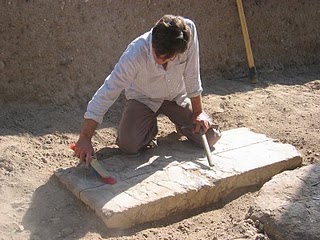
And it is a good thing we decided to take the picture. Last Friday we decided to expand the area of Grid 47, where I work in the theatre, in order to better expose the entirety of the building. So today we had a little extra help and the results couldn't be more impressive -- or messy, truth be told. We'll be cleaning up for a while but that's okay. We'll also have a much better understanding of the building.
So what exactly did we do? Well, stay tuned for pictures from tomorrow's work.
Wednesday is our first tell tour so we should be able to get the scoop on the other grids.
And for today a return to "Who? What? When?" 
Until next time, the dirt is ready. Get digging!
Finding Artifacts

Work continues and everyone seems to be making progress. I went on a field trip to Grid 51 today and saw Dr. Kate's newly expanded empire which is quite impressive. One of the most interesting things I saw in her grid was a floor made of mudbrick tiles! There were a number of other interesting things to see in the grid and I hope to post pictures soon so that everyone back home can see all the exciting material.
We have found a number of interesting artifacts in Grid 47 this week from the very large to the very small. For instance, we found a large architectural fragment. We think it might have decorated the of the theatre we are excavating. Ryan is making sure that the marble fragment is labeled so that we know where it came from. Behind him, Mark is entering data into the computer so that everything is recorded properly. We have been finding many pieces of the building as we dig. We have found roof tiles, floor tiles. fresco fragments, mosaic floor fragments and much more. Today we also found a blade or knife made out of iron. The most exciting thing about it was that part of the wooden handle was still preserved which is rather unusual. The knife came from a pit where we found a lot of interesting things including lots of broken pots, a large number of iron nails and lots and lots of bones.
And finally, for the students at Hamilton Elementary. Perry was there when Emily, one of our volunteers, found her fourth oil lamp of the summer! Everyone agrees she is very lucky.
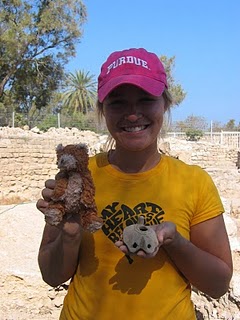 I want to send out a big thank you to the Hamilton students and families who have been following our work here on the Leon Levy Expedition to Ashkelon. I know that the school year is almost over but you can keep following our work until July 16th when the season ends.
I want to send out a big thank you to the Hamilton students and families who have been following our work here on the Leon Levy Expedition to Ashkelon. I know that the school year is almost over but you can keep following our work until July 16th when the season ends.
Next entry the answer to our last "What? Where? When?" And hopefully, a new staff member for everyone to meet.
Until then, the dirt is plentiful.
Who Becomes an Archaeologist?
Who becomes an archaeologist? Good question. There are as many different answers as there are people doing archaeology. Today in our first "Getting to Know You" segment I'm going to introduce one member of our team of archaeologists. I was hoping to have the video working but since that hasn't happened yet I'm just posting a brief paragraph about Dr. Kate.
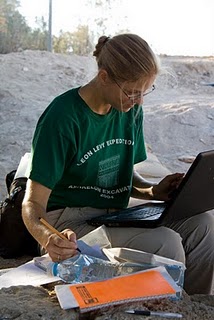 Kate has a Ph.D. in archaeology from Harvard where she studied the pottery of the Sea Peoples on the coasts and inland in Anatolia & northern Syria (The Philistines are part of the larger phenomenon of the "Sea Peoples"). When in elementary school, she dreamed of becoming either a conductor or a donut maker. While she still daydreams of pastries, she is now the fearless leader of an entire area of excavation. In this area, she supervises the excavation of material from the Islamic through the Persian periods. During the excavation, Kate spends her mornings teaching the square supervisors how to be better excavators. In the afternoon, she "reads" pottery & teaches her supervisors & volunteers about the pottery that has been dug up during the morning.
Kate has a Ph.D. in archaeology from Harvard where she studied the pottery of the Sea Peoples on the coasts and inland in Anatolia & northern Syria (The Philistines are part of the larger phenomenon of the "Sea Peoples"). When in elementary school, she dreamed of becoming either a conductor or a donut maker. While she still daydreams of pastries, she is now the fearless leader of an entire area of excavation. In this area, she supervises the excavation of material from the Islamic through the Persian periods. During the excavation, Kate spends her mornings teaching the square supervisors how to be better excavators. In the afternoon, she "reads" pottery & teaches her supervisors & volunteers about the pottery that has been dug up during the morning.
Favorite Tool: Pick Axe
Coming soon the answer to the most recent "What? Where? When?" and the next installment of "Getting to Know You."
The Professionals
 This week Grids 47 and Grids 38 benefited from the assistance of a team of professionals. First up, Jeffrey, Lucy and Noah. After helping with the cleanup in Grid 47 they went on to Grid 38 where they were able to help in the digging there. The trio did an excellent job shoveling dirt, collecting pottery and bringing smiles to the grid.
This week Grids 47 and Grids 38 benefited from the assistance of a team of professionals. First up, Jeffrey, Lucy and Noah. After helping with the cleanup in Grid 47 they went on to Grid 38 where they were able to help in the digging there. The trio did an excellent job shoveling dirt, collecting pottery and bringing smiles to the grid.
Jeffrey, Lucy and Noah weren't the only ones to help in Grid 47 this week. Today the head of the excavation Dr. Master took the opportunity to get his trowel dirty excavating monumental Roman architecture with us.
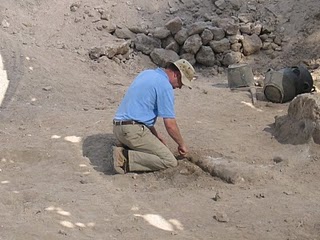 As director of the excavation Dr. Master is very busy and doesn't often have time to dig in the dirt so it was a thrill for us and exciting for him (I'm sure) to spend a few moments in the dirt. Stay tuned for an interview with Dr. Master as the season progresses. We'll soon have an opportunity to ask him about what is new at the ancient city of Ascalon.
As director of the excavation Dr. Master is very busy and doesn't often have time to dig in the dirt so it was a thrill for us and exciting for him (I'm sure) to spend a few moments in the dirt. Stay tuned for an interview with Dr. Master as the season progresses. We'll soon have an opportunity to ask him about what is new at the ancient city of Ascalon.
As I've mentioned before Grid 47 isn't the only place that we are excavating. Today I wandered on over to Grid 38 to see what they are doing there. In Grid 38 they are excavating a Late Bronze Age house which dates to the 13th century BCE. The house has beaten earth floors and mudbrick walls. When the house went out of use, when the residents left, people used the area for large grain silos that cut through the earlier houses. In one picture you see the ladder that leads to John's square. This square has the latest (or more recent) material in Grid 38. John has Roman and Persian period material as well as material from the Iron Age. He has a long way to go until he catches up with everyone else in the Late Bronze Age. In the other picture you can see another one of Grid 38's Square Supervisors, Madeleine. She is hard at work at her computer. We use laptops in the field to record all of our work and discoveries. By putting everything on the computer it makes it easier for other scholars to see our research as they do their own work.

